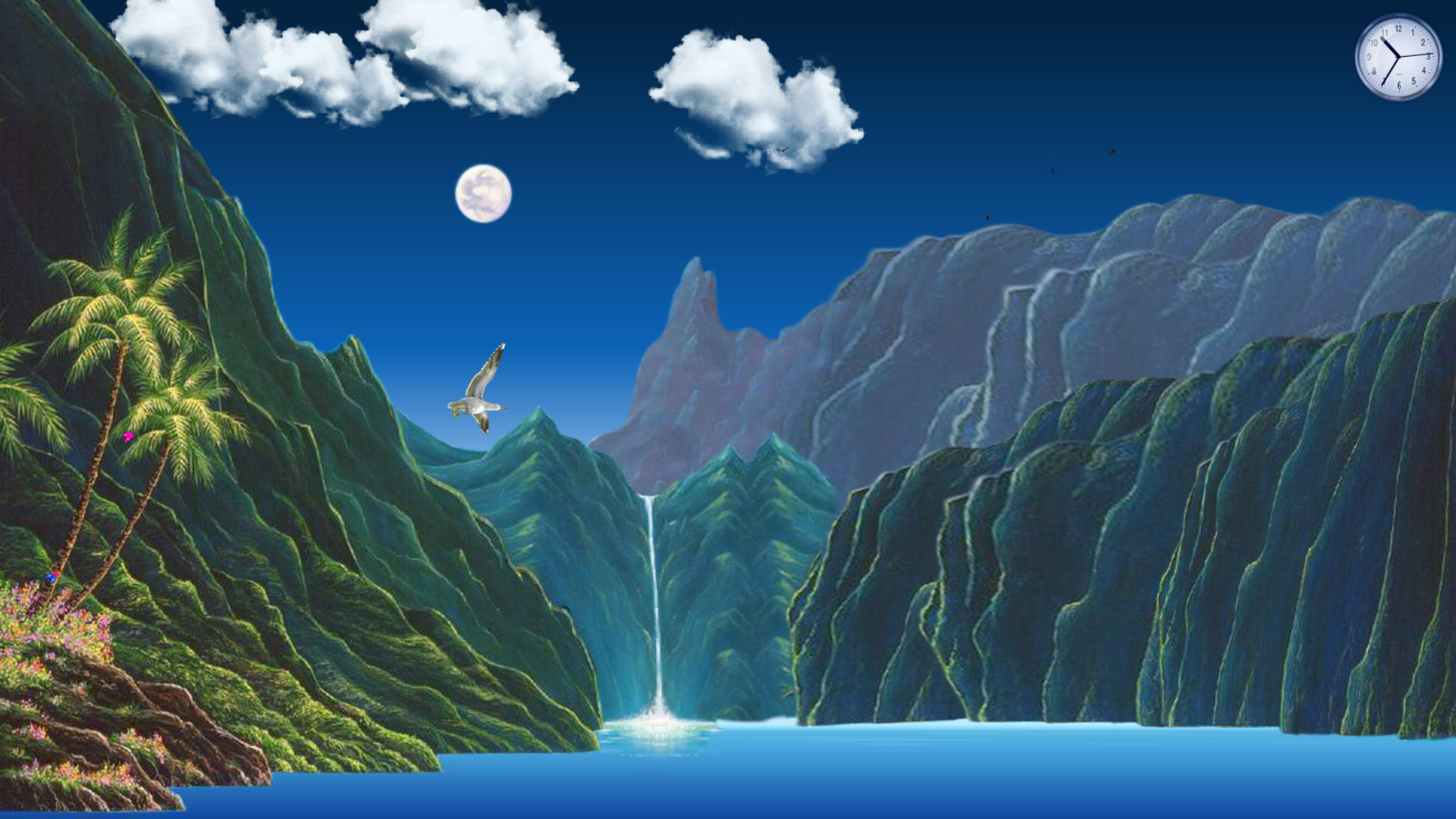Windows 8 introduced major changes to the operating system's platform and user interface intended to improve its user experience on tablets, where Windows was now competing with mobile operating systems, including Android and iOS. Windows 8 added support for USB 3.0, Advanced Format hard drives, near field communications, and cloud computing. Reviews of the various editions of Windows 8 were mixed to negative. Pierce also considered the Start Screen to be a "brilliant innovation for desktop computers" when compared with "folder-littered desktops on every other OS" because it allows users to interact with dynamic information. In contrast, an ExtremeTech article said it was Microsoft "flailing" and a review in PC Magazine condemned the Metro-style user interface. Some of the included apps in Windows 8 were considered to be basic and lacking in functionality, but the Xbox apps were praised for their promotion of a multi-platform entertainment experience.
Other improvements and features were also regarded as positive changes. Windows 8 introduces significant changes to the operating system's user interface, many of which are aimed at improving its experience on tablet computers and other touchscreen devices. The new user interface is based on Microsoft's Metro design language and uses a Start screen similar to that of Windows Phone 7 as the primary means of launching applications. The Start screen displays a customizable array of tiles linking to various apps and desktop programs, some of which can display constantly updated information and content through "live tiles". As a form of multi-tasking, apps can be snapped to the side of a screen. Alongside the traditional Control Panel, a new simplified and touch-optimized settings app known as "PC Settings" is used for basic configuration and user settings.
It does not include many of the advanced options still accessible from the normal Control Panel. After the deadline, only critical security updates were to be released for users on these platforms. After this new policy faced criticism from users and enterprise customers, Microsoft partially retracted the change and stated that both operating systems would remain supported on Skylake hardware through the end of their Extended support lifecycle.
Windows 8.1 remains officially unsupported on all newer CPU families, and neither AMD or Intel will provide official chipset drivers for Windows operating systems other than Windows 10. However, on August 2016, Microsoft again extended the Skylake support policy until the end of support for Windows 7 and 8.1 . The new Start menu takes after Windows 7's design by using only a portion of the screen and including a Windows 7-style application listing in the first column. Myerson said that these changes would occur in a future update, but did not elaborate. Windows Phone 8.1 would share nearly 90% of the common Windows Runtime APIs with Windows 8.1 on PCs.
Windows 10 received generally positive reviews upon its original release. Critics also praised the improvements to Windows 10's bundled software over Windows 8.1, Xbox Live integration, as well as the functionality and capabilities of the Cortana personal assistant and the replacement of Internet Explorer with Microsoft Edge. Following the unveiling of Windows 8, Microsoft faced criticism for mandating that devices receiving its optional certification for Windows 8 have secure boot enabled by default using a key provided by Microsoft. Concerns were raised that secure boot could prevent or hinder the use of alternate operating systems such as Linux. It also revealed that ARM devices would be required to have secure boot permanently enabled, with no way for users to disable it. Windows 8 provides heavier integration with online services from Microsoft and others.
A user can now log into Windows with a Microsoft account, which can be used to access services and synchronize applications and settings between devices. Windows 8 also ships with a client app for Microsoft's SkyDrive cloud storage service, which also allows apps to save files directly to SkyDrive. A SkyDrive client for the desktop and File Explorer is not included in Windows 8, and must be downloaded separately. Bundled multimedia apps are provided under the Xbox brand, including Xbox Music, Xbox Video, and the Xbox SmartGlass companion for use with an Xbox 360 console. Games can integrate into an Xbox Live hub app, which also allows users to view their profile and Gamerscore. Other bundled apps provide the ability to link Flickr and Facebook.
Due to Facebook Connect service changes, Facebook support is disabled in all bundled apps effective June 8, 2015. Download Windows 12 Lite ISO 64 bit Release Date, Features ISO Microsoft. Now the most relevant and common Microsoft operating system is Windows 10, which was released in the summer of 2015. Nevertheless, it was not too long to remain the latest in its class, since it would soon be introduced, and then a new platform for computers, tablets, laptops and other electronic devices would be released, and it was called Windows 12. Currently, the American corporation , which creates it, does not advertise its upcoming release of new windows 12 release date, but this is indicated by many obvious facts, which are simply impossible not to notice. It is already known what window 12 features it will be able to please all users when it comes out.
In addition, it is known how much a license will cost for microsoft windows 12 release date . Extended support until January 13, 2032The original release of Windows 10 receives mainstream support for five years after its original release, followed by five years of extended support, but this is subject to conditions. Microsoft stated that these devices would no longer receive feature updates, but would still receive security updates through January 2023.
Microsoft will continue to support at least one standard Windows 10 release until October 14, 2025. A vertical toolbar known as the charms provides access to system and app-related functions, such as search, sharing, device management, settings, and a Start button. The traditional desktop environment for running desktop applications is accessed via a tile on the Start screen.
Will There Be A Free Upgrade To Windows 12 The Start button on the taskbar from previous versions of Windows has been converted into a hotspot (or "hot corner") in the lower-left corner of the screen, which displays a large tooltip displaying a thumbnail of the Start screen. However, Windows 8.1 added the start button back to the taskbar after many complaints, but removed the preview thumbnail. Swiping from the left edge of a touchscreen or clicking in the top-left corner of the screen allows one to switch between apps and Desktop. Pointing the cursor in the top-left corner of the screen and moving down reveals a thumbnail list of active apps. Aside from the removal of the Start button and the replacement of the Aero Glass theme with a flatter and solid-colored design, the desktop interface on Windows 8 is similar to that of Windows 7. Other critics argued that Microsoft should not have triggered any downloading of Windows 10 installation files without user consent.
Feature updates prior to version 1909 are distributed solely as an in-place upgrade installation, requiring the download of a complete operating system package (approximately 3.5 GB in size for 64-bit systems). Unlike previous builds, version 1909 is designed primarily as an update rollup version of 1903, focusing primarily on minor feature additions and enhancements. For upgrades to 1909 from 1903, a new delivery method is used where its changes were delivered as part of the monthly cumulative update, but are left in a dormant state until the 1909 update "enablement" patch is installed.
The full upgrade process is still used for those using builds prior to 1903. A new iteration of the Start menu is used on the Windows 10 desktop, with a list of places and other options on the left side, and tiles representing applications on the right. The menu can be resized, and expanded into a full-screen display, which is the default option in Tablet mode.
A new virtual desktop system was added by a feature known as Task View, which displays all open windows and allows users to switch between them, or switch between multiple workspaces. Universal apps, which previously could be used only in full screen mode, can now be used in self-contained windows similarly to other programs. Program windows can now be snapped to quadrants of the screen by dragging them to the corner. When a window is snapped to one side of the screen, Task View appears and the user is prompted to choose a second window to fill the unused side of the screen (called "Snap Assist"). The upgrade offer was marketed and initiated using the "Get Windows 10" application, which was first downloaded and installed via Windows Update in March 2015. Registry keys and group policies could be used to partially disable the GWX mechanism, but the installation of patches to the GWX software via Windows Update could reset these keys back to defaults, and thus reactivate the software.
Third-party programs were also created to assist users in applying measures to disable GWX. This edition is designed for "special-purpose devices" that perform a fixed function . For this reason, it excludes Cortana, Microsoft Store, and all bundled Universal Windows Platform apps . The interface of Windows 8 has been the subject of negative reaction. Despite this "stumbling block", Bright said that Windows 8's interface worked well in some places, but began to feel incoherent when switching between the "Metro" and desktop environments, sometimes through inconsistent means.
He noted that while forcing all users to use the new touch-oriented interface was a risky move for Microsoft as a whole, it was necessary in order to push development of apps for the Windows Store. If in previous versions of Windows 12 the Dark Mode feature on the Windows 12 theme includes Settings, Microsoft Edge, Groove Music, Calculator, and other Windows 12 default applications. However, On Windows 12 Update, Microsoft complements this shortcoming by adding the Dark Mode feature to File Explorer. The presence of Dark Mode on Windows 12 This update certainly complements the Dark Mode experience on Windows 12. In addition, for those of you who like to use dark mode and work at night, then this can be one of the superior features that will definitely be much liked. You can do file processing and execute files through thecontext menu with a dark background display with light writing.
As per the sources, the Windows 12 release date will be on December 29, 2020. As revealed by Microsoft it is testing a new feature "download cloud" to reset your operating system when the hardware fails or the OS needs to be reinstalled in windows 12. Although this feature is not yet available for public testing, it will appear on devices when you boot a system under these conditions. This feature will likely be very critical for future Microsoft Windows Lite and Windows Core OS . This feature will probably be a step which is similar to the way Apple handles macOS reinstallations, with the given option to reinstall the OS by downloading a copy from the cloud. In March 2016, some users also alleged that their Windows 7 and 8.1 devices had automatically begun upgrading to Windows 10 without their consent.
In June 2016, the GWX dialog's behavior changed to make closing the window imply a consent to a scheduled upgrade. It was concluded that these users may have unknowingly clicked the "Accept" prompt without full knowledge that this would begin the upgrade. On July 29, 2015, Microsoft officially announced that Windows 10 would be released for retail purchase as a free upgrade from earlier versions of Windows. On May 2, 2017, Microsoft unveiled Windows 10 S , a feature-limited edition of Windows 10 which was designed primarily for devices in the education market , such as the Surface Laptop that Microsoft also unveiled at this time.
The OS restricts software installation to applications obtained from Microsoft Store; the device may be upgraded to Windows 10 Pro for a fee to enable unrestricted software installation. As a time-limited promotion, Microsoft stated that this upgrade would be free on the Surface Laptop until March 31, 2018. Windows 10 S also contains a faster initial setup and login process, and allows devices to be provisioned using a USB drive with the Windows Intune for Education platform. During the January 21 event, Microsoft demonstrated its "continuum" approach to developing Windows 11.
Continuum is designed to adapt Windows to the form factor of the equipment on which it works. When the tablet is connected to an overlay to the keyboard, Surface Pro 3 works like a laptop, which technically it is. Then, as soon as the keyboard is removed, a small icon appears at the bottom right of the screen, asking if you want to activate tablet mode.
This action changes all applications to full screen, which makes the icons a bit larger and allows users to access the initial screen as in Windows 8, but much more updated. As soon as you plug in the keyboard, the device prompts you to return to the original mode. Windows 11 Release Date Microsoft plans to further merge the desktop and the modern user interface. Simply put, Microsoft will allow modern UI applications to run from the desktop, in "window" mode, and attach to the "Start" menu instead of the start screen.
Part of the work was started in Windows 8.1 and can be continued in subsequent updates to Windows 11. Device Guard is designed to protect against zero-day exploits, and runs inside a hypervisor so that its operation remains separated from the operating system itself. As for the stable general availability version of Windows 12 June 2022 Update, it should be released in the coming year. 10 Home and Pro is "Semi-Annual Channel " (formerly "Current Branch", or "CB"), which receives stable builds after they are publicly released by Microsoft. Each build of Windows 10 is supported for 18 months after its original release. In enterprise environments, Microsoft officially intends that this branch is used for "targeted" deployments of newly released stable versions so that they can be evaluated and tested on a limited number of devices before a wider deployment.
10 product keys, meaning they could be entered during installation to activate the free license, without the need to upgrade first to "activate" the hardware with Microsoft's activation servers. Since the release of the Fall Creators Update , Microsoft decided to release multi-edition installation media, to alleviate installation and product activation issues users experienced because of accidentally installing the wrong edition of Windows 10. Windows 10 introduces Microsoft Edge, a new default web browser. It initially featured a new standards-compliant rendering engine derived from Trident, and also includes annotation tools and integration with other Microsoft platforms present within Windows 10. Internet Explorer 11 is maintained on Windows 10 for compatibility purposes, but is deprecated in favor of Edge and will no longer be actively developed.
In January 2020, the initial version of Edge was succeeded by a new iteration derived from the Chromium project and the Blink layout engine and the old Edge based on EdgeHTML is now called 'Microsoft Edge Legacy'. The legacy version of Edge is currently being replaced by the new Chromium-based Edge via Windows Update, though this version can also be downloaded manually. Every Windows 10 version from 20H2, which was released on October 20, 2020, will come with the new version of the browser preinstalled. The Windows 10 October 2020 update added a price comparison tool to the Edge browser. On September 30, 2014, Microsoft officially announced that Threshold would be unveiled during a media event as Windows 10.
Myerson said that Windows 10 would be Microsoft's "most comprehensive platform ever", providing a single, unified platform for desktop and laptop computers, tablets, smartphones, and all-in-one devices. He emphasized that Windows 10 would take steps towards restoring user interface mechanics from Windows 7 to improve the experience for users on non-touch devices, noting criticism of Windows 8's touch-oriented interface by keyboard and mouse users. Despite these concessions, Myerson noted that the touch-optimized interface would evolve as well on 10. Windows 10 is a major release of the Windows NT operating system developed by Microsoft. It is the successor to Windows 8.1, which was released nearly two years earlier, and itself was released to manufacturing on July 15, 2015, and broadly released for the general public on July 29, 2015. Windows 10 was made available for download via MSDN and TechNet, as a free upgrade for retail copies of Windows 8 and Windows 8.1 users via the Windows Store, and to Windows 7 users via Windows Update.
Windows 10 receives new builds on an ongoing basis, which are available at no additional cost to users, in addition to additional test builds of Windows 10, which are available to Windows Insiders. Devices in enterprise environments can receive these updates at a slower pace, or use long-term support milestones that only receive critical updates, such as security patches, over their ten-year lifespan of extended support. In June 2014, state broadcaster China Central Television broadcast a news story further characterizing Windows 8 as a threat to national security. Prior to its general availability on October 26, 2012, updates were released for some of Windows 8's bundled apps, and a "General Availability Cumulative Update" was released on Tuesday, October 9, 2012. Microsoft indicated that due to improvements to its testing infrastructure, general improvements of this nature are to be released more frequently through Windows Update instead of being relegated to OEMs and service packs only. Despite these shortcomings, 60 million Windows 8 licenses were sold through January 2013, a number that included both upgrades and sales to OEMs for new PCs.
Build, test and demo software across an array of different devices, platforms and clouds. IT professionals, developers and businesses rely on Workstation Pro every day to support their projects and customers. Workstation Pro makes it easy to run complex local virtual environments to simulate operating systems, platforms and clouds, all from the same desktop PC. The Verge has reported that Microsoft concedes it won't "block you from installing Windows 11 on a PC with an older CPU," if you do so using a clean install from an ISO disk image file. Meanwhile, Bleeping Computer reported that Microsoft also says the Trusted Platform Module 2 requirement can be bypassed using an ISO image or the Windows 10 Media Creation Tool. While Microsoft obviously isn't recommending either of these routes to Windows 11, it does appear to be turning a technical blind eye which will allow users of older devices that don't meet the official hardware requirements to update.
This edition is an update for Windows Phone 8.1 and is designed for smartphones, tablets, and mini tablets with screen sizes up to 8-inches. It will not be sold at retail or as a separate update, but instead will only be available as an update for existing users with phones running Windows Phone 8.1 platform or for new devices. Mobile Windows 11 has Continuum support for the phone, but only on new, currently released devices. If the Microsoft Surface family of products isn't your style though, other brands like Dell, Asus and HP have all released pages online that specify what devices are Windows 11 ready. Note that many won't come with the new operating system installed, but as they all meet the minimum system requirements, you can simply buy the laptop or 2-in-1 as normal and then update it yourself. Critics have acknowledged that Microsoft's update and testing practices had been affecting the overall quality of Windows 10.
In particular, it was pointed out that Microsoft's internal testing departments had been prominently affected by a major round of layoffs undertaken by the company in 2014. Microsoft relies primarily on user testing and bug reports via the Windows Insider program , as well as correspondence with OEMs and other stakeholders. In the wake of the known folder redirection data loss bug in the version 1809, it was pointed out that bug reports describing the issue had been present on the Feedback Hub app for several months prior to the public release. Following the incident, Microsoft updated Feedback Hub so that users may specify the severity of a particular bug report. On December 7, 2016, Microsoft announced that, as part of a partnership with Qualcomm, it planned to introduce support for running Win32 software on ARM architecture with a 32-bit x86 processor emulator, in 2017. Microsoft is initially targeting this project towards laptops.
Unlike previous versions of Windows, Windows Update does not allow the selective installation of updates, and all updates are downloaded and installed automatically. Users can only choose whether their system will reboot automatically to install updates when the system is inactive, or be notified to schedule a reboot. Version 1703 allows wired networks to be designated as metered, but Windows may still download certain updates while connected to a metered network. The Anniversary Update added Windows Subsystem for Linux , which allows the installation of a user space environment from a supported Linux distribution that runs natively on Windows.
The subsystem translates Linux system calls to those of the Windows NT kernel . The environment can execute the Bash shell and 64-bit command-line programs (WSL 2 also supports 32-bit Linux programs and graphics, assuming supporting software installed, and GPUs support for other uses). Windows applications cannot be executed from the Linux environment, and vice versa. Linux distributions for Windows Subsystem for Linux are obtained through Microsoft Store. The feature initially supported an Ubuntu-based environment; Microsoft announced in May 2017 that it would add Fedora and OpenSUSE environment options as well.





























No comments:
Post a Comment
Note: Only a member of this blog may post a comment.